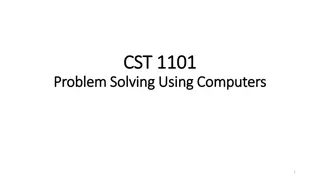Exploring Equations in Two Variables
Explore the creation and graphing of linear equations in two variables to represent relationships between quantities. Understand the concept of slope, y-intercept, and the slope-intercept form of equations. Practice creating tables of values, writing algebraic equations, and graphing on coordinate axes to visualize mathematical relationships.
Download Presentation

Please find below an Image/Link to download the presentation.
The content on the website is provided AS IS for your information and personal use only. It may not be sold, licensed, or shared on other websites without obtaining consent from the author. Download presentation by click this link. If you encounter any issues during the download, it is possible that the publisher has removed the file from their server.
E N D
Presentation Transcript
CREATING AND GRAPHING IN 2- VARIABLES Standard: Standard: MGSE9-12.A.CED.2 Create linear, quadratic, and exponential equations in two or more variables to represent relationships between quantities; graph equations on coordinate axes with labels and scales. Essential Question: Essential Question: How can graphing equations help you make decisions?
Warm Up Warm Up A cell phone company charges a $20 flat fee plus $0.05 for every minute used for calls. 1. Make a table of values from 0 to 60 minutes in 10-minute intervals that represent the total amount charged. 2. Write an algebraic equation that could be used to represent the situation. 3. What do the unknown values in your equation represent?
Introduction Introduction Many relationships can be represented by linear equations. Linear equations in two be written in the form y y = = mx slope slope and b is the y y- -intercept intercept. The slope of a linear graph is a measure of the rate of change of one variable with respect to another variable. The y-intercept of the equation is the point at which the graph crosses crosses the y-axis and the value of x is zero zero. two variables can mx + + b b, where m is the rate of change
Introduction, continued Creating a linear equation in two variables from context follows the same procedure at first for creating an equation in one variable. Start by reading the problem carefully. Once you have created the equation, the equation can be graphed on the coordinate plane. The coordinate plane is a set of two number lines, called the axes, that intersect at right angles.
Key Concepts Key Concepts Reviewing Linear Equations: The slope slope of a linear equation is also defined by the ratio ratio of the rise of the graph compared to the run. Given two points on a line, (x1, y1) and (x2, y2), the slope is the ratio of the change change in the y y- -values values of the points (rise) to the change in the corresponding x x- -values the points (run). ????? =???? values of ???=?? ?? ?? ??
Key Concepts, Key Concepts, continued The slope slope- -intercept intercept form of an equation of a line is often used to easily identify the slope and y y- -intercept can be used to graph the line. The slope-intercept form of an equation is shown below, where m represents the slope of the line and b represents the y y- -value the line intersects the y-axis at point (0, y). ? = ?? + ? continued intercept, which then slope value of the point where Horizontal Horizontal lines have a slope of 0. They have a run but no rise. Vertical Vertical lines have no slope.
Key Concepts, Key Concepts, continued The x x- -intercept intercept of a line is the point where the line intersects the x-axis at (x, 0). continued If a point lies on a line, its coordinates make the equation true true. The graph of a line is the collection that satisfy the equation. collection of all points
The graph of the linear equation ? = 2? + 2 is shown, with its x- and y-intercepts plotted.
Key Concepts, Key Concepts, continued Determining the Scale and Labels When Graphing: If the slope slope has a rise and run between 10 and 10 and the y-intercept is 10 or less, use a grid that has squares equal to 1 unit 1 unit. Adjust Adjust the units according to what you need. For example, if the y-intercept is 10,000, each square might represent 2,000 units on the y-axis. Be careful when plotting plotting the slope to take into account the value each grid square represents continued represents.
Key Concepts, Key Concepts, continued Sometimes you need to skip makes sense to do this if the y-intercept is very large (positive positive) or very small (negative negative). For example, if your y-intercept is 10,000, you could start your y- axis numbering at 0 and skip to 10,000 at the next y-axis number. Use a short, zigzag at 0 to about the first grid line to show that you ve skipped values. Then continue with the correct numbering numbering for the rest of the axis. continued skip values on the y-axis. It zigzag line starting
Key Concepts, Key Concepts, continued Only use x- and y-values that make sense for the context context of the problem. Ask yourself if negative negative values make sense for the x-axis and y-axis labels in terms of the context. If negative values don t make sense (for example, time and distance can t have negative values), only use positive positive values. continued
Key Concepts, Key Concepts, continued Determine the independent and dependent variables. continued The independent variable will be labeled on the x-axis. The independent variable independent variable is the quantity that changes based on values you choose. The dependent variable will be labeled on the y-axis. The dependent variable is the quantity that is based on the input values of the independent variable.
Graphing Equations Using the Slope and y-intercept 1. Plot the y-intercept first. The y-intercept will be on the y-axis. 2. Recall that slope is ???? ???. Change the slope into a fraction if you need to. 3. To find the rise when the slope is positive, count up the number of units on your coordinate plane the same number of units in your rise. (So, if your slope is ? ?, you count up 3 on the y-axis.) 4. For the run, count over to the right the same number of units on your coordinate plane in your run, and plot the second point. (For the slope? ?, count 5 to the right and plot your point.)
5. To find the rise when the slope is negative, count down the number of units on your coordinate plane the same number of units in your rise. For the run, you still count over to the right the same number of units on your coordinate plane and plot the second point. (For a slope of ? ?, count down 4, right 7, and plot your point. 6. Connect the points and place arrows at one or both ends of the line when it makes sense to have arrows within the context of the problem. 7. Label the line with the equation.
Guided Practice Guided Practice Example 1 Example 1 A local convenience store owner spent $10 on pencils to resell at the store. What is the equation of the store s revenue if each pencil sells for $0.50? Graph the equation.
Guided Practice Guided Practice Example 2 Example 2 A taxi company in Atlanta charges $2.50 per ride plus $2 for every mile driven. Write and graph the equation that models this scenario.
Guided Practice Guided Practice Example 3 Example 3 Miranda gets paid $300 a week to deliver groceries. She also earns 5% commission on any orders she collects while out on her delivery run. Write an equation that represents her weekly pay and then graph the equation.
Guided Practice Guided Practice Example 4 Example 4 The velocity (or speed) of a ball thrown directly upward can be modeled with the following equation: v = gt + v0 Here, v is the speed, g is the force of gravity, t is the elapsed time, and v0is the initial velocity at time 0. If the force of gravity is equal to 32 feet per second, and the initial velocity of the ball is 96 feet per second, what is the equation that represents the velocity of the ball? Graph the equation.
Guided Practice Guided Practice Example 5 Example 5 A Boeing 747 starts out a long flight with about 57,260 gallons of fuel in its tank. The airplane uses an average of 5 gallons of fuel per mile. Write an equation that models the amount of fuel in the tank and then graph the equation.
Problem Based Task: Phone Card Fine Problem Based Task: Phone Card Fine Print Print Write and graph the equation that models the following Write and graph the equation that models the following scenario. scenario. You can buy a 6-hour phone card for $5, but the fine print says that each minute you talk actually costs you 1.5 minutes of time. What is the equation that models the number of minutes left on the card compared with the number of minutes you actually talked? What is the graph of this equation?























